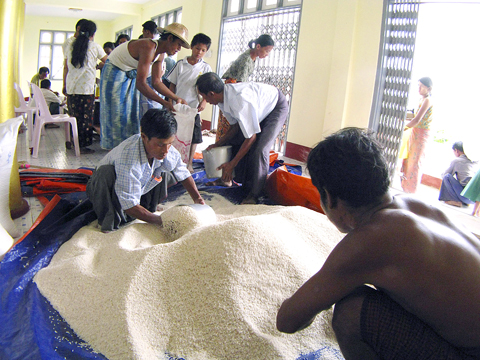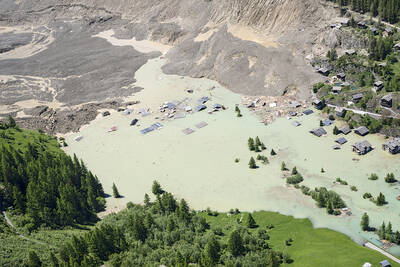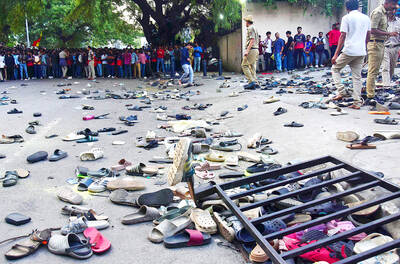In helping others, Myanmar’s saffron-robed Buddhist monks have helped themselves.
The monks’ critical role in providing relief after Cyclone Nargis has galvanized their ranks and strengthened their political voice — just months after the junta quashed the democracy uprising spearheaded by the monks last fall.
The monks have channeled aid materials into stricken regions and turned monasteries into soup kitchens and refugee camps since the May 2-3 storm.

PHOTO: AP
Their outreach to survivors — many of whom received little or no government help — highlighted the monks’ power and the possibility they could clash again with Myanmar’s ruling forces. Some monks are even building secret stashes of makeshift weapons, clerics say.
While Buddhism orders its clergy to shun violence and politics, monks in Myanmar and elsewhere in Asia have a history of militancy.
The monk Saya San became a national hero in the 1930s by leading a revolt against the British colonialists who hanged him after fielding 12,000 troops to suppress his peasant army.
In more recent times, monks were at the forefront of a 1988 uprising against the junta and led mass street demonstrations which the military crushed last fall.
An expert on Myanmar affairs, retired Rutgers University professor Josef Silverstein, said the monks’ post-storm mobilization is consistent with beliefs of Buddhist in the country.
“These beliefs didn’t disappear because the military hit them over the head last year,” he said by telephone. “The monks are angry and they’re seeing that no one else is stepping forward” to lead relief efforts — or political opposition.
A Yangon monk — one of a dozen interviewed — said it was impossible to “close our eyes to a government that cares so little for the people that it allows them to suffer and die.” He spoke on condition of anonymity because of the intense government scrutiny of monks and the sensitivity of discussing anti-government action in this tightly controlled nation.
His monastery has collected and distributed truckloads of blankets, tarpaulins and food to storm survivors. And, like hundreds of other monasteries throughout Myanmar’s storm-struck southwest, it also became a temporary shelter for those who lost their homes.
Short and wiry with fiery eyes, the monk spoke in hushed but urgent tones as he blamed the ruling generals for failing to adequately warn people of the cyclone, which killed at least 78,000 and left an additional 56,000 missing.
He also blamed government restrictions on foreign aid for putting millions of survivors at risk of starvation and disease.
“As monks, it’s our responsibility to fight for a change,” said the monk, as he fingered a scar that he said came from a melee with authorities during last September’s crackdown.
He displayed part of a secret cache, consisting of a half-dozen slingshots, and said he was working with monks in several cities to collect more weapons for storage at other secret locations. Most of them were rudimentary devices patched together from everyday objects such as bamboo rods and bicycle spokes and chains, he said, declining to give numbers and other details for security reasons.
The extent of the weapons gathering could not be independently confirmed.
But other monks interviewed in Yangon and Mandalay said they had heard of colleagues building weapons stashes, though they stressed they were not hoarding weapons themselves.
Monks are also trying to obtain guns to make any clashes “less one-sided,” said the Yangon monk.
Though Myanmar’s monks often explain their relief work in religious terms, some acknowledge its political undertones.
“Whenever you do things for the people, you are engaging in politics,” said U Zaw Ti Ka, an elderly abbot at another monastery in Mandalay. “Here the government is against the people, so if you do something for the people, you are also doing it against the government.”
He said he abhors the violence that marred September’s protests — but understands those who want to use force against the government.
“To make a Christian comparison, this is a real David and Goliath situation,” the monk said. “What we need now are not slingshots. What we need are real guns.”

The collapse of the Swiss Birch glacier serves as a chilling warning of the escalating dangers faced by communities worldwide living under the shadow of fragile ice, particularly in Asia, experts said. Footage of the collapse on Wednesday showed a huge cloud of ice and rubble hurtling down the mountainside into the hamlet of Blatten. Swiss Development Cooperation disaster risk reduction adviser Ali Neumann said that while the role of climate change in the case of Blatten “still needs to be investigated,” the wider impacts were clear on the cryosphere — the part of the world covered by frozen water. “Climate change and

Poland is set to hold a presidential runoff election today between two candidates offering starkly different visions for the country’s future. The winner would succeed Polish President Andrzej Duda, a conservative who is finishing his second and final term. The outcome would determine whether Poland embraces a nationalist populist trajectory or pivots more fully toward liberal, pro-European policies. An exit poll by Ipsos would be released when polls close today at 9pm local time, with a margin of error of plus or minus 2 percentage points. Final results are expected tomorrow. Whoever wins can be expected to either help or hinder the

Packed crowds in India celebrating their cricket team’s victory ended in a deadly stampede on Wednesday, with 11 mainly young fans crushed to death, the local state’s chief minister said. Joyous cricket fans had come out to celebrate and welcome home their heroes, Royal Challengers Bengaluru, after they beat Punjab Kings in a roller-coaster Indian Premier League (IPL) cricket final on Tuesday night. However, the euphoria of the vast crowds in the southern tech city of Bengaluru ended in disaster, with Indian Prime Minister Narendra calling it “absolutely heartrending.” Karnataka Chief Minister Siddaramaiah said most of the deceased are young, with 11 dead

DENIAL: Musk said that the ‘New York Times was lying their ass off,’ after it reported he used so much drugs that he developed bladder problems Elon Musk on Saturday denied a report that he used ketamine and other drugs extensively last year on the US presidential campaign trail. The New York Times on Friday reported that the billionaire adviser to US President Donald Trump used so much ketamine, a powerful anesthetic, that he developed bladder problems. The newspaper said the world’s richest person also took ecstasy and mushrooms, and traveled with a pill box last year, adding that it was not known whether Musk also took drugs while heading the so-called US Department of Government Efficiency (DOGE) after Trump took power in January. In a